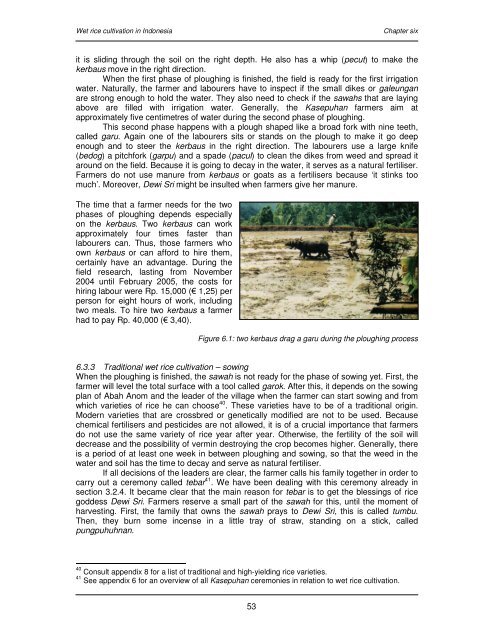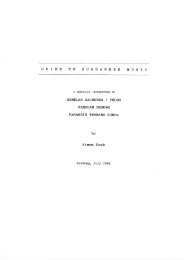Wet rice cultivation in Indonesia - Free EBooks Library
Wet rice cultivation in Indonesia - Free EBooks Library
Wet rice cultivation in Indonesia - Free EBooks Library
Create successful ePaper yourself
Turn your PDF publications into a flip-book with our unique Google optimized e-Paper software.
<strong>Wet</strong> <strong>rice</strong> <strong>cultivation</strong> <strong>in</strong> <strong>Indonesia</strong> Chapter six<br />
it is slid<strong>in</strong>g through the soil on the right depth. He also has a whip (pecut) to make the<br />
kerbaus move <strong>in</strong> the right direction.<br />
When the first phase of plough<strong>in</strong>g is f<strong>in</strong>ished, the field is ready for the first irrigation<br />
water. Naturally, the farmer and labourers have to <strong>in</strong>spect if the small dikes or galeungan<br />
are strong enough to hold the water. They also need to check if the sawahs that are lay<strong>in</strong>g<br />
above are filled with irrigation water. Generally, the Kasepuhan farmers aim at<br />
approximately five centimetres of water dur<strong>in</strong>g the second phase of plough<strong>in</strong>g.<br />
This second phase happens with a plough shaped like a broad fork with n<strong>in</strong>e teeth,<br />
called garu. Aga<strong>in</strong> one of the labourers sits or stands on the plough to make it go deep<br />
enough and to steer the kerbaus <strong>in</strong> the right direction. The labourers use a large knife<br />
(bedog) a pitchfork (garpu) and a spade (pacul) to clean the dikes from weed and spread it<br />
around on the field. Because it is go<strong>in</strong>g to decay <strong>in</strong> the water, it serves as a natural fertiliser.<br />
Farmers do not use manure from kerbaus or goats as a fertilisers because ‘it st<strong>in</strong>ks too<br />
much’. Moreover, Dewi Sri might be <strong>in</strong>sulted when farmers give her manure.<br />
The time that a farmer needs for the two<br />
phases of plough<strong>in</strong>g depends especially<br />
on the kerbaus. Two kerbaus can work<br />
approximately four times faster than<br />
labourers can. Thus, those farmers who<br />
own kerbaus or can afford to hire them,<br />
certa<strong>in</strong>ly have an advantage. Dur<strong>in</strong>g the<br />
field research, last<strong>in</strong>g from November<br />
2004 until February 2005, the costs for<br />
hir<strong>in</strong>g labour were Rp. 15,000 (€ 1,25) per<br />
person for eight hours of work, <strong>in</strong>clud<strong>in</strong>g<br />
two meals. To hire two kerbaus a farmer<br />
had to pay Rp. 40,000 (€ 3,40).<br />
Figure 6.1: two kerbaus drag a garu dur<strong>in</strong>g the plough<strong>in</strong>g process<br />
6.3.3 Traditional wet <strong>rice</strong> <strong>cultivation</strong> – sow<strong>in</strong>g<br />
When the plough<strong>in</strong>g is f<strong>in</strong>ished, the sawah is not ready for the phase of sow<strong>in</strong>g yet. First, the<br />
farmer will level the total surface with a tool called garok. After this, it depends on the sow<strong>in</strong>g<br />
plan of Abah Anom and the leader of the village when the farmer can start sow<strong>in</strong>g and from<br />
which varieties of <strong>rice</strong> he can choose 40 . These varieties have to be of a traditional orig<strong>in</strong>.<br />
Modern varieties that are crossbred or genetically modified are not to be used. Because<br />
chemical fertilisers and pesticides are not allowed, it is of a crucial importance that farmers<br />
do not use the same variety of <strong>rice</strong> year after year. Otherwise, the fertility of the soil will<br />
decrease and the possibility of verm<strong>in</strong> destroy<strong>in</strong>g the crop becomes higher. Generally, there<br />
is a period of at least one week <strong>in</strong> between plough<strong>in</strong>g and sow<strong>in</strong>g, so that the weed <strong>in</strong> the<br />
water and soil has the time to decay and serve as natural fertiliser.<br />
If all decisions of the leaders are clear, the farmer calls his family together <strong>in</strong> order to<br />
carry out a ceremony called tebar 41 . We have been deal<strong>in</strong>g with this ceremony already <strong>in</strong><br />
section 3.2.4. It became clear that the ma<strong>in</strong> reason for tebar is to get the bless<strong>in</strong>gs of <strong>rice</strong><br />
goddess Dewi Sri. Farmers reserve a small part of the sawah for this, until the moment of<br />
harvest<strong>in</strong>g. First, the family that owns the sawah prays to Dewi Sri, this is called tumbu.<br />
Then, they burn some <strong>in</strong>cense <strong>in</strong> a little tray of straw, stand<strong>in</strong>g on a stick, called<br />
pungpuhuhnan.<br />
40 Consult appendix 8 for a list of traditional and high-yield<strong>in</strong>g <strong>rice</strong> varieties.<br />
41 See appendix 6 for an overview of all Kasepuhan ceremonies <strong>in</strong> relation to wet <strong>rice</strong> <strong>cultivation</strong>.<br />
53








